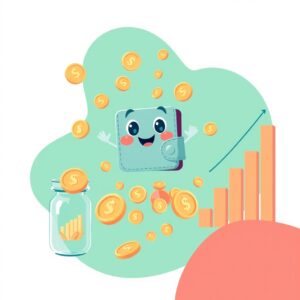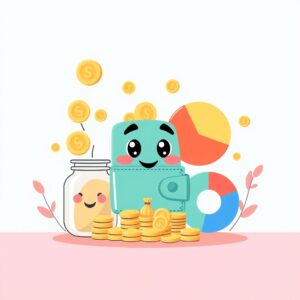Estimated reading time: 6 minutes
Key Takeaways
- Control grocery spending by setting a specific budget.
- Reduce food waste through mindful shopping and meal planning.
- Promote healthier eating habits by planning meals in advance.
- Utilize apps and tools for efficient budgeting and tracking.
- Implement strategies like using coupons, bulk buying, and opting for store brands to save money.
Table of Contents
- Understanding How to Budget for Groceries
- Setting Up a Grocery Spending Tracker
- Creating a Weekly Meal Budget Planner
- Utilizing Apps to Save Money on Groceries
- Top Grocery Budget Apps for iOS
- Strategies to Effectively Save Money on Groceries
- Integrating Budgeting Tools for Comprehensive Management
- Conclusion & Call-to-Action
Understanding How to Budget for Groceries
Definition:
Learning how to budget for groceries means setting aside a specific amount of money for food and household items weekly or monthly. This practice offers numerous benefits:
- Avoiding Overspending: Keeps your finances aligned with your overall budget.
- Promoting Healthy Eating: Encourages planned meals, reducing the impulse to purchase unhealthy food.
- Minimizing Waste: Helps in mindful shopping, reducing excess food purchase (source).
Using a grocery spending tracker, a critical component of budgeting, further enhances this process by identifying areas where you can improve financially. Explore how to use a daily expense tracker app to maximize your budgeting efficiency.
Setting Up a Grocery Spending Tracker
Explanation
A grocery spending tracker can be digital or paper-based, serving as a tool for recording every grocery purchase you make. This full awareness of your spending patterns can help:
- Recognize and adjust areas where there is overspending.
- Encourage smarter shopping choices by identifying high-cost items.
Recommended Methods & Tools
To track effectively:
- Use budgeting apps like Excel, Google Sheets, or a printable log.
- Categorize purchases (produce, meats, dairy) for even greater clarity.
- Consider using a digital envelope budgeting app for more structured budget management.
Tracking spending allows more control over your budget, fostering healthier eating habits and less waste (source).
Creating a Weekly Meal Budget Planner
Importance of Meal Planning
A weekly meal budget planner creates structured shopping lists that fit your grocery budget, reducing impulse buys, limiting waste, and supporting healthier eating (source, source).
Step-by-Step Guide
- Evaluate Your Schedule: Identify busy days versus free days when planning meals.
- Plan Meals: Cover breakfast, lunch, dinner, and snacks for each day.
- Check Inventory: Use pantry items first to avoid buying duplicates.
- Budget Adjustments: Substitute pricier ingredients as necessary.
- Stick to Your List: Follow your prepared list during shopping trips.
Sample Templates
Find templates at these sources, adaptable for various dietary needs:
Using a weekly meal budget planner ensures your grocery spending remains on track, supporting a structured and efficient shopping habit.
Utilizing Apps to Save Money on Groceries
Overview of Grocery Budgeting & Shopping Apps
Apps designed to save money on groceries come packed with features like:
- Receipt Scanning: Capture receipts digitally.
- Coupons and Loyalty Integrations: Access special savings and benefits.
- Price Comparisons: Identify cheaper options for the same product.
These apps enhance efficiency, providing digital discounts and tracking tools. They simplify the budgeting process by offering accurate, real-time spending data. For a comprehensive comparison, check out Pennies App vs YNAB.
Features to Look For
When selecting a save money on groceries app, consider options with:
- Price Comparisons: Find cheapest stores.
- Rebate Features: Gain cashback on purchases.
- Meal-Planning Add-ons: Integrate meal plans into the app.
- Reminder Notifications: Stay aware of upcoming deals.
- Spending Analysis: Gain insights into spending habits.
Choosing the right app encourages more effective grocery budgeting, helping you maintain control over your expenses.
Top Grocery Budget Apps for iOS
Introduction to Grocery Budget App iOS
Grocery budget apps are tailored for iOS devices, simplifying budgeting processes. By combining different functionalities like budgeting, shopping, and meal planning, these apps streamline your grocery management.
App Reviews (Examples)
- YNAB (You Need a Budget): Offers comprehensive budgeting with expense tracking. Though subscription-based, it includes robust features.
- EveryDollar: Uses envelope-style budgeting for simplicity. Quick setup, though some features require payments.
- Mealime: Focuses on meal planning and generates grocery lists automatically; less emphasis on full budgeting.
- Flipp: Specializes in coupons, store circulars, and price matching; excellent for bargain hunters.
Tips on Choosing the Right App
Ensure the app aligns with personal preferences and requirements, whether your focus is on meal planning, savings, or full budgeting. Matching app features to personal needs gives you the best benefit.
Strategies to Effectively Save Money on Groceries
Additional Recommendations
Maximize savings further by employing strategies such as:
- Coupons and Store Programs: Take advantage of available discounts.
- Bulk Buying: Purchase non-perishables in larger quantities for a reduced price.
- Opt for Store Brands: Typically cheaper than name brands.
- Shop with a List and Not Hungry: Curbs impulse purchases (source).
Additionally, implementing a 30-day no spend challenge can significantly boost your savings and enhance your grocery budgeting habits.
Encourage Unit Price Comparisons
Determining the price per ounce/gram can reveal the most economical options, providing more savings over time.
Integrating Budgeting Tools for Comprehensive Management
Combined Approach
Using a grocery spending tracker, weekly meal budget planner, and money saving app together creates a comprehensive budgeting tool:
- Frequent Reviews: Adjust for price changes, season variations, or household needs.
- Syncing Data: For multiple digital tools, keep them updated and interconnected for awareness.
An integrated approach ensures seamless and efficient grocery budget management. For more insights, refer to our guide on how to track discretionary spending.
Conclusion & Call-to-Action
To budget for groceries, mastering tracking, planning, and the use of digital apps is essential. These strategies offer benefits like reduced spending, limited waste, healthier meals, and improved financial management.
Action Steps
Start immediately with one strategy — set up a grocery spending tracker, draft a weekly meal budget planner, or download a grocery budget app for iOS. Embrace the tools and knowledge you’ve gained to create smarter grocery habits (source, source, source, source).
By setting a grocery budget and utilizing these tools, you secure better control over your food expenses and contribute positively to your overall financial health.




